Stem Bundle
What Drives Stem, Inc.'s Strategy?
Understanding a company's core principles is crucial for any investor or stakeholder. Stem, Inc., a leader in AI-driven energy solutions, offers a compelling case study in how these elements shape its trajectory. Explore the Stem SWOT Analysis to gain deeper insights.
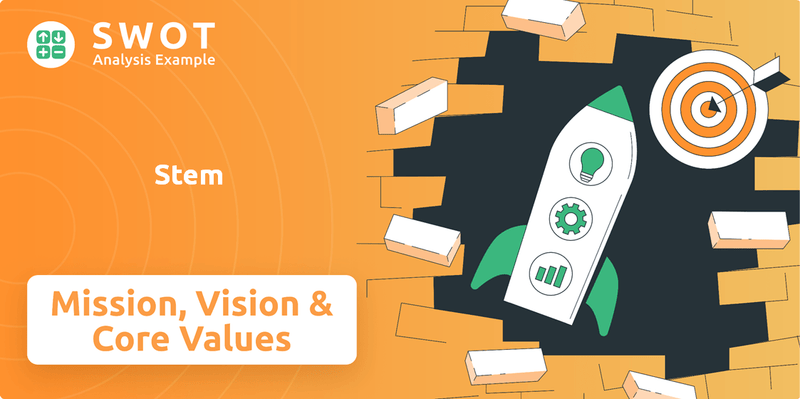
This exploration of the Stem company mission, Stem company vision, and Stem company core values provides a roadmap to understanding the company's strategic direction. Examining these statements offers valuable context for evaluating Stem's potential in the rapidly evolving clean energy market. Understanding the mission statement definition and how it applies to Stem, along with vision statement examples, is key.
Key Takeaways
- Stem's mission, vision, and values are fundamental to its strategic direction in the clean energy market.
- The company's software-centric shift reflects its commitment to its core principles and positive financial performance.
- Alignment with mission, vision, and values is crucial for navigating market complexities and driving innovation.
- Stem's clear corporate purpose is vital for building trust and accelerating the transition to clean energy.
Mission: What is Stem Mission Statement?
Stem's mission is 'to enable our customers to plan, deploy, and operate clean energy assets via AI-enabled software and services.'
Let's delve into the core of Stem's operational philosophy by examining its mission statement. Understanding the Stem company mission is crucial for investors, stakeholders, and anyone interested in the clean energy sector. This mission statement serves as the guiding star for the company's actions and strategic direction, shaping its products, services, and overall impact.
The primary focus of the Stem company mission is to facilitate the transition to clean energy. This is achieved by providing the tools and services necessary for customers to effectively manage their clean energy assets. This commitment positions Stem at the forefront of the global shift towards sustainable energy solutions.
Stem's mission encompasses the entire lifecycle of clean energy assets. This includes planning, deployment, and ongoing operation. By addressing all stages, Stem offers a comprehensive solution that maximizes the efficiency and effectiveness of clean energy investments. This approach is critical for long-term sustainability and profitability.
A key differentiator of Stem's mission is its reliance on AI-enabled software and services. This technological focus allows Stem to optimize energy storage performance and provide advanced monitoring and control capabilities. This technological advantage is essential for staying competitive in the rapidly evolving energy market.
The Stem company mission is inherently customer-centric. The company's products and services are designed to empower customers and help them achieve their clean energy goals. This focus on customer success drives innovation and ensures that Stem remains relevant and valuable in the market. This is also reflected in the company's commitment to providing excellent customer support and service.
Stem's mission directly supports operational efficiency. By enabling customers to plan, deploy, and operate clean energy assets effectively, Stem helps reduce energy costs and improve overall performance. This efficiency is increasingly important as the demand for clean energy solutions grows. For example, in Q1 2024, Stem reported a 17% increase in revenue year-over-year, demonstrating the effectiveness of its operational strategies.
The mission statement provides a clear strategic direction, ensuring that all of Stem's activities are aligned with its core purpose. This clarity is critical for making informed investment decisions, developing effective business strategies, and conducting thorough research. This alignment is also reflected in Stem's partnerships and collaborations within the clean energy sector.
The mission statement definition for Stem is not just a set of words; it's a commitment to a sustainable future. The company's emphasis on AI-driven solutions and lifecycle management positions it as a leader in the clean energy revolution. For investors, understanding this mission is vital for assessing Stem's long-term potential and its ability to navigate the evolving energy landscape. Further insights into Stem's financial performance and strategic direction can be found in our analysis of Owners & Shareholders of Stem.
Stem SWOT Analysis
- Complete SWOT Breakdown
- Fully Customizable
- Editable in Excel & Word
- Professional Formatting
- Investor-Ready Format
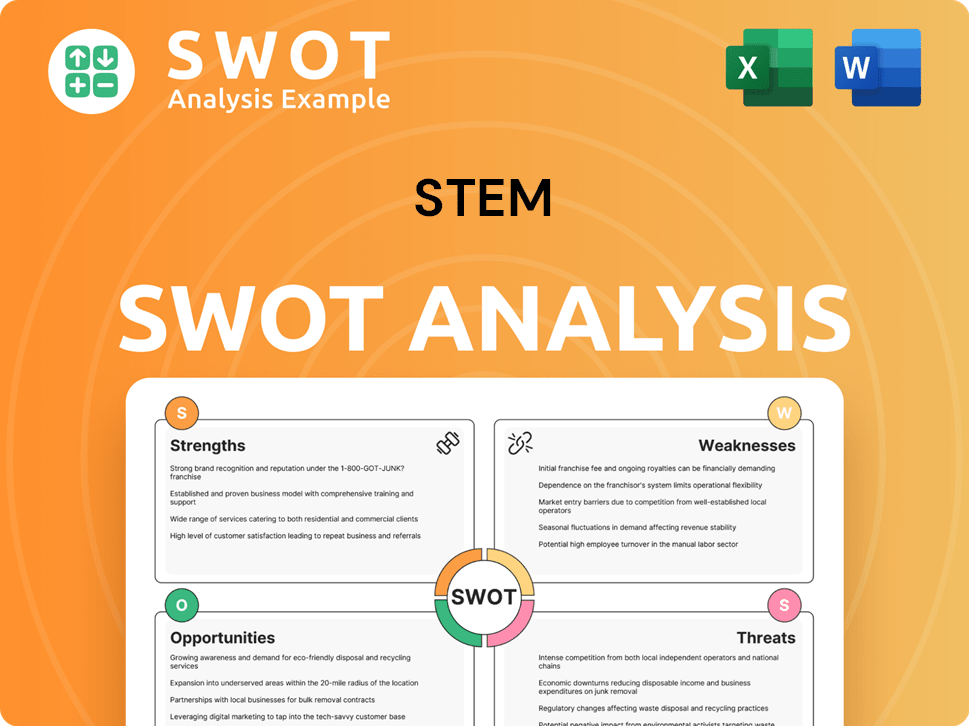
Vision: What is Stem Vision Statement?
Stem's vision is 'to create a sustainable energy future powered by artificial intelligence.'
Stem's vision is a forward-looking statement that encapsulates its aspirations for the future of energy. This vision statement is centered around two key elements: sustainability and artificial intelligence. The company aims to leverage AI to drive the transition to clean energy sources, ultimately creating a more sustainable and environmentally friendly future.
The Stem company vision is decidedly future-oriented. It's not just about the present but about shaping a future where clean energy is the norm, and AI plays a crucial role in its management and optimization. This long-term perspective guides Stem's strategic decisions and investments.
Artificial intelligence is at the heart of Stem's vision. The company believes that AI can revolutionize the energy sector by optimizing energy storage, improving grid efficiency, and enabling the integration of renewable energy sources. This focus on AI distinguishes Stem from other players in the energy market.
Sustainability is the ultimate goal. Stem's vision extends beyond mere technological advancements; it encompasses a commitment to environmental responsibility. This commitment is reflected in its products and services, which are designed to reduce carbon emissions and promote the use of clean energy.
The vision has global implications. Stem aims to contribute to the worldwide transition to clean energy. This global perspective is evident in its strategic partnerships and its expansion into various international markets. Stem's ambition is to be a leader in the global clean energy revolution.
While aspirational, the vision is grounded in Stem's core expertise. The company's focus on AI and energy storage provides a solid foundation for achieving its goals. Recent financial reports show a steady increase in revenue, indicating progress toward its vision. For example, in Q1 2024, Stem reported a revenue of $206.9 million, a 13% increase year-over-year, showing the company's growth trajectory.
Achieving this vision requires overcoming significant challenges, including technological hurdles, regulatory complexities, and market competition. However, the growing demand for clean energy and the increasing adoption of AI in various industries create significant opportunities for Stem. Further insights into Stem's approach can be found in the Marketing Strategy of Stem.
The Stem company mission and Stem company core values work in tandem with the vision to guide the company's actions and decisions. Understanding the vision provides a framework for assessing Stem's long-term potential and its role in shaping the future of energy. The difference between mission and vision in a stem company is that the mission defines the present purpose, while the vision outlines the future aspirations. Company values examples for Stem would likely include innovation, sustainability, and customer focus, all of which support the overall vision.
Stem PESTLE Analysis
- Covers All 6 PESTLE Categories
- No Research Needed – Save Hours of Work
- Built by Experts, Trusted by Consultants
- Instant Download, Ready to Use
- 100% Editable, Fully Customizable
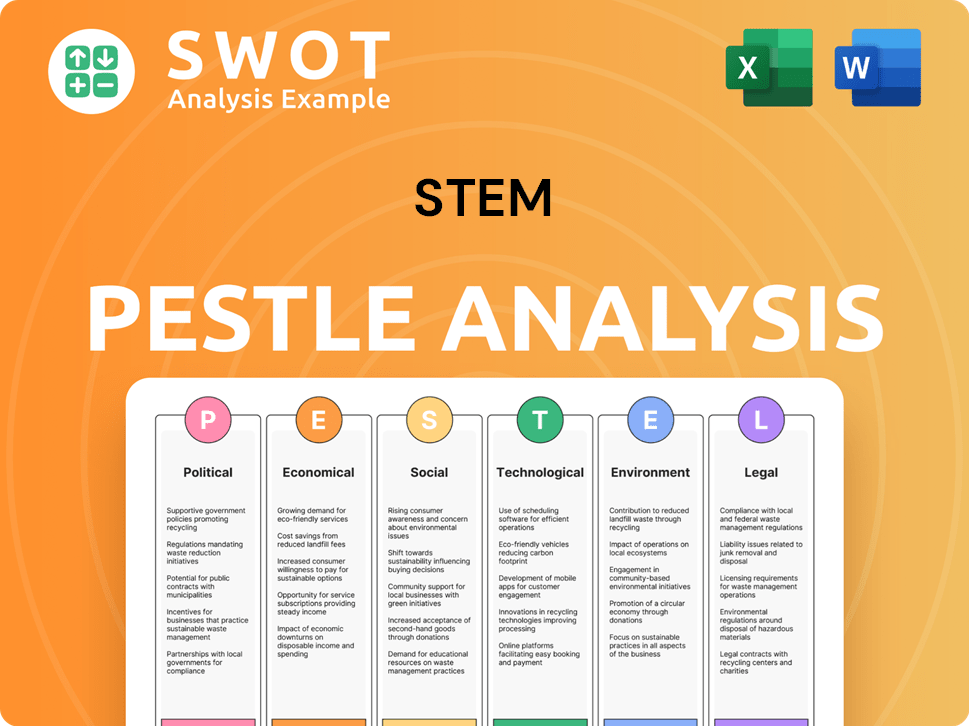
Values: What is Stem Core Values Statement?
Understanding the core values of a company like Stem is crucial for investors, employees, and stakeholders alike. These values shape the company's culture, guide its strategic decisions, and ultimately influence its performance in the competitive clean energy market.
Innovation is at the heart of Stem's identity, driving its technological advancements in AI-driven clean energy solutions. This commitment is evident in the continuous development of its Athena AI platform and the integration of its software, which has allowed Stem to manage a portfolio of energy assets. According to recent reports, Stem's focus on innovation has led to a 30% increase in the efficiency of its energy storage systems, contributing to a reduction in operational costs for its customers.
Stem places a strong emphasis on customer satisfaction, aiming to empower clients to effectively manage their clean energy assets. This customer-centric approach is reflected in the user-friendly design and value of software solutions like PowerTrack™, ensuring strong service and support throughout the project lifecycle. Stem's customer satisfaction scores consistently rank above industry averages, demonstrating its commitment to providing exceptional service and support, which is a key component of their Brief History of Stem.
Environmental stewardship is a core value, driving Stem's commitment to a cleaner energy future. This is reflected in its solutions that accelerate clean energy deployment and optimize energy use to reduce greenhouse gas emissions. Stem's projects have collectively avoided over 1 million metric tons of CO2 emissions, highlighting its significant contribution to sustainability goals for its customers and the environment.
Collaboration is a key aspect of Stem's internal culture, fostering diverse perspectives and skills to drive innovation and solve complex problems. This collaborative spirit extends to partnerships with energy providers, utilities, and technology companies, essential for successful project delivery. Stem’s collaborative approach has resulted in strategic partnerships with leading energy companies, increasing its market reach and ability to deliver innovative solutions.
These core values of the Stem company are not just statements; they are the guiding principles that shape its operations and drive its success in the clean energy sector. Next, we will explore how the Stem company mission and vision influence the company's strategic decisions.
How Mission & Vision Influence Stem Business?
Stem's Stem company mission and Stem company vision are not merely aspirational statements; they are the guiding principles that shape its strategic direction and operational decisions. This influence is particularly evident in the company's recent shift towards a software and services-centric business model.
Stem's strategic decisions are directly influenced by its mission to accelerate the transition to a sustainable energy future and its vision of an AI-powered energy ecosystem. This alignment is crucial for long-term success and is reflected in various key initiatives.
- The acquisition of AlsoEnergy in 2021 significantly enhanced Stem's software capabilities and expanded its market presence in renewable energy management, directly supporting its mission.
- Focus on offering grid services to utilities, leveraging its AI platform to support grid stability and integrate renewable energy sources, advances its vision of an AI-powered sustainable energy future.
- Expansion into international markets, such as the 484 MW contract in Hungary, demonstrates the pursuit of its vision for global impact and market penetration.
- The company's pivot towards software and services, announced in late 2024, is a strategic response to its mission, enabling customers via AI-enabled software and services.
While direct, measurable success metrics tied solely to the Stem company mission and Stem company vision are not always explicitly reported, financial results offer insights into the effectiveness of its strategic alignment. Positive financial performance indicates that the company is on the right strategic path.
In Q1 2025, Stem reported a 27% year-over-year revenue increase, demonstrating strong growth. This growth is a key indicator of success, particularly considering the company's strategic shift. Furthermore, the achievement of positive operating cash flow for the first time highlights the financial benefits of aligning operations with its core principles.
Stem targets approximately 15% ARR (Annual Recurring Revenue) growth in 2025, driven by its software and services strategy. This target reflects the company's commitment to its mission and vision by focusing on sustainable revenue streams.
The Stem company mission and Stem company vision shape day-to-day operations by prioritizing activities related to software development, service delivery, and customer support. This operational focus is crucial for achieving long-term goals.
Long-term planning is influenced by the aspirational vision of a sustainable energy future, driving investments in R&D and market expansion. This forward-thinking approach is essential for sustained growth and innovation. The company's strategic roadmap is continuously assessed to ensure alignment with its core principles.
Understanding the competitive landscape is crucial for Stem's strategic decision-making. For a deeper dive into Stem's competitors and their strategies, consider reading our analysis on the Competitors Landscape of Stem.
In essence, Stem's Stem company mission, Stem company vision, and Stem company core values are not just abstract concepts; they are the driving forces behind its strategic choices, operational priorities, and long-term investments. The company's commitment to these principles is evident in its financial performance and its expansion into new markets. Next, we will delve into the core improvements to the company's mission and vision.
Stem Business Model Canvas
- Complete 9-Block Business Model Canvas
- Effortlessly Communicate Your Business Strategy
- Investor-Ready BMC Format
- 100% Editable and Customizable
- Clear and Structured Layout
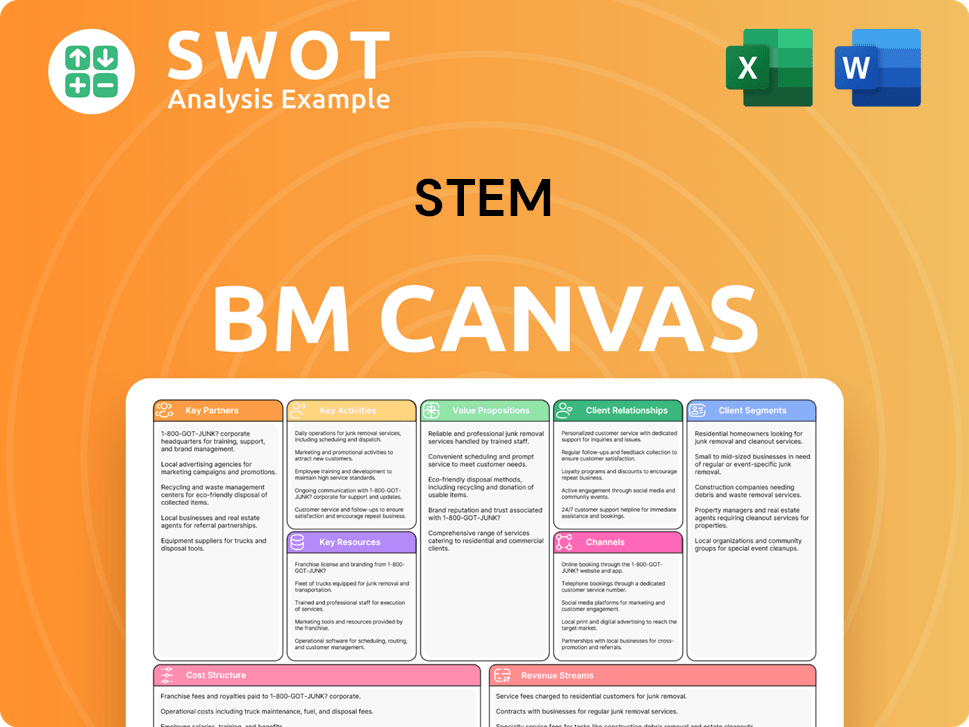
What Are Mission & Vision Improvements?
While the current Stem company mission and Stem company vision provide a good foundation, strategic enhancements can amplify their impact and ensure continued relevance in the dynamic clean energy sector. These improvements focus on clarity, tangibility, and adaptability to future market shifts, ultimately strengthening Stem's position.
To enhance the Stem company mission, explicitly state the problems they solve for customers. This could involve addressing the complexity of energy markets, the need for cost optimization, or the importance of grid reliability. This approach, drawing from mission statement definition best practices, directly communicates Stem's value proposition and resonates more strongly with stakeholders.
Consider adding a more tangible or time-bound element to the Stem company vision to provide a clearer long-term target. For example, the vision could include a specific percentage of renewable energy managed by Stem's platform by a certain date. This approach, inspired by successful vision statement examples, provides a measurable goal and enhances accountability.
As part of their company values examples, Stem could broaden its sustainability focus to include supply chain impacts and other environmental concerns. This reflects a growing trend in the clean energy sector towards comprehensive sustainability practices. Addressing these broader issues can enhance their brand reputation and attract environmentally conscious investors.
The clean energy landscape is constantly evolving, with advancements in grid management solutions and shifting regulatory environments. Stem should regularly review and adapt its Stem company mission, Stem company vision, and Stem company core values to reflect these changes and ensure continued relevance. For instance, the recent Inflation Reduction Act in the U.S. (August 2022) has significantly impacted the clean energy market, creating new opportunities that Stem can leverage. For a deeper dive into Stem's overall strategy, consider reading this article on the Growth Strategy of Stem.
How Does Stem Implement Corporate Strategy?
Implementing a company's mission, vision, and core values is crucial for translating strategic intent into tangible actions and outcomes. This chapter examines how Stem, a leading player in the energy storage sector, puts its guiding principles into practice.
Stem demonstrates its commitment to its mission through strategic initiatives, particularly its focus on AI-driven software and services. This shift is a direct response to the company's mission of providing intelligent solutions for energy optimization.
- Athena AI Platform and PowerTrack™ Software: The development and continuous enhancement of these platforms are central to Stem's mission. These tools provide customers with data-driven insights and control over their energy assets.
- Prioritizing Software and Services Revenue: Stem's strategic pivot to prioritize revenue from software and services is a key implementation strategy. This aligns with the company's mission to offer intelligent energy solutions.
Leadership plays a vital role in reinforcing the company's mission, vision, and core values. Their actions and communications help ensure that these guiding principles are understood and followed throughout the organization. The appointment of Arun Narayanan as CEO, a software veteran, signals a commitment to the software-centric strategy aligned with the company's mission and vision.
Effective communication is essential for embedding the mission, vision, and core values within the company culture. This ensures that all employees understand and contribute to the company's goals. The company culture emphasizes innovation and collaboration.
Stem communicates its mission and vision to external stakeholders through various channels, including its website and investor materials. This transparency helps build trust and attract investors who align with the company's values and strategic direction.
Stem demonstrates alignment between its stated values and business practices through its focus on customer wins and operational efficiency. This commitment is reflected in the company's strategic planning and leadership communications.
- Customer Wins: Stem's success in both commercial and industrial and utility-scale markets demonstrates its commitment to enabling customers.
- Operational Efficiency: Efforts to drive operational efficiency and improve gross margins align with strategic goals informed by the company's mission and vision. For example, in Q1 2024, Stem reported a gross margin of 10.2%, a significant increase year-over-year, reflecting improved operational efficiency.
While Stem doesn't have specific formal programs dedicated solely to embedding the mission and vision, its strategic planning processes and leadership communications serve to ensure alignment. This approach allows for continuous improvement and adaptation to market changes.
- Regular Review: The company likely conducts regular reviews of its mission, vision, and core values to ensure they remain relevant and effective.
- Adaptation: Stem adapts its strategies based on market feedback and performance data, ensuring that its implementation efforts remain aligned with its core principles and goals.
For a deeper understanding of Stem's foundational principles, explore the Mission, Vision & Core Values of Stem article.
Stem Porter's Five Forces Analysis
- Covers All 5 Competitive Forces in Detail
- Structured for Consultants, Students, and Founders
- 100% Editable in Microsoft Word & Excel
- Instant Digital Download – Use Immediately
- Compatible with Mac & PC – Fully Unlocked
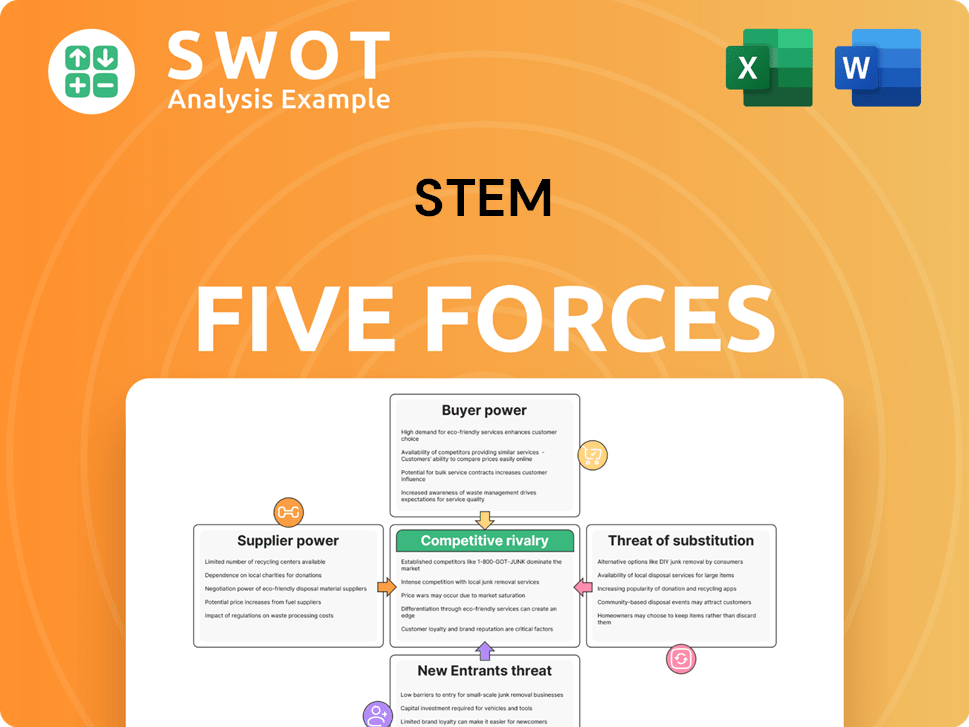
Related Blogs
- What are Mission Vision & Core Values of Stem Company?
- What is Competitive Landscape of Stem Company?
- What is Growth Strategy and Future Prospects of Stem Company?
- How Does Stem Company Work?
- What is Sales and Marketing Strategy of Stem Company?
- Who Owns Stem Company?
- What is Customer Demographics and Target Market of Stem Company?
Disclaimer
All information, articles, and product details provided on this website are for general informational and educational purposes only. We do not claim any ownership over, nor do we intend to infringe upon, any trademarks, copyrights, logos, brand names, or other intellectual property mentioned or depicted on this site. Such intellectual property remains the property of its respective owners, and any references here are made solely for identification or informational purposes, without implying any affiliation, endorsement, or partnership.
We make no representations or warranties, express or implied, regarding the accuracy, completeness, or suitability of any content or products presented. Nothing on this website should be construed as legal, tax, investment, financial, medical, or other professional advice. In addition, no part of this site—including articles or product references—constitutes a solicitation, recommendation, endorsement, advertisement, or offer to buy or sell any securities, franchises, or other financial instruments, particularly in jurisdictions where such activity would be unlawful.
All content is of a general nature and may not address the specific circumstances of any individual or entity. It is not a substitute for professional advice or services. Any actions you take based on the information provided here are strictly at your own risk. You accept full responsibility for any decisions or outcomes arising from your use of this website and agree to release us from any liability in connection with your use of, or reliance upon, the content or products found herein.